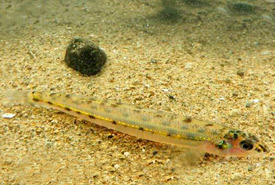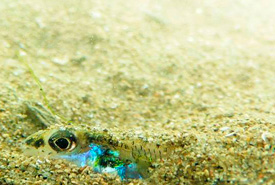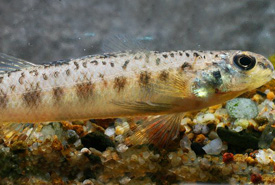Something's Fishy: Risky business

Eastern sand darter, Grand River, ON (Photo by Alan Dextrase/Ontario Ministry of Natural Resources and Forestry) © Queen's Printer for Ontario, 2016
Close your eyes and think back to the best gift you’ve ever received. Was it that shiny red bike you got for your 10th birthday, a sentimental gift from a loved one or a token you still cherish to this day?
When I think back to the most prized gift I ever received, it isn’t a possession like that beloved red five-speed bike; it is the moment in time I knew I was looking at an endangered species.
An endangered species sighting is a present from nature. An honour has been bequeathed upon you so priceless, you hold onto this moment so it doesn’t flee from memory.
This was my exact feeling when I saw an eastern sand darter. I blinked hard, as I shielded my eyes from the sun, to see a sandy-coloured needle in a haystack of daces, minnows and sculpins. After closely examining its small, translucent body marked with dark lateral spots, I confirmed the ID of my gift.

Eastern sand darter buried in the sandy bottom of Grand River, ON (Photo by Alan Dextrase/Ontario Ministry of Natural Resources and Forestry) © Queen's Printer for Ontario, 2016
Eastern sand darters’ clever colouring allows the species sufficient camouflage in their habitual dwellings. Unlike most Canadian freshwater fish, female eastern sand darters will bury themselves in the sand to lay their eggs. Both genders will use sand to hide from potential predators and to stay put in fast waters. In Canada, this species is known to frequent the sandy bottoms of lakes, streams and rivers in several parts of Ontario and in Quebec (in the St. Lawrence River and its tributaries).
Since 1950, once-abundant populations of the eastern sand darter have disappeared from several southern Ontario watersheds, despite the rediscovery of three eastern sand darters in Big Creek (near Norfolk) in 2008 after a 50-year absence.
That same year, the Ministry of Natural Resources and Forestry listed the Ontario population of eastern sand darters as endangered. The following year, the Committee on the Status of Endangered Wildlife in Canada (COSEWIC) listed the Quebec population as at-risk/threatened.
The foremost threat to these darter populations is siltation, which happens when too much soil washes into a river, lake or stream. Siltation creates muddy water and can cover sand bars with sediment. This can kill the eastern sand darter’s eggs and limit oxygen flow for burrowing fish. This is highly problematic in urbanized and agricultural areas.

Channel darter (Photo by J.R. Shute/Conservation Fisheries)
Another threat to eastern sand darters is the invasive round goby. Since both species share the same habitat and prey, eastern sand darters are forced to compete with the goby for food.
Recovery strategies for the eastern sand darter aim to help ensure the species’ habitats are safe. The species is protected under Ontario’s Endangered Species Act and the federal Species at Risk Act.
Closely related to the eastern sand darter is the channel darter, a species listed as threatened by COSEWIC. Although there are no recordings of the eastern sand darter on Nature Conservancy of Canada (NCC) properties, channel darters have been found on Quebec’s Kenauk property. NCC is implementing strategic conservation actions to ensure the survival of the channel darter on this property.
The joy from that sunny spring outing when I first spotted a sand darter still resonates with me to this day. I still feel the same tingling I felt when I confirmed my findings with countless field guides and fish-fuelled debates on the water. I had been given a gift opened by few; an experience I will never forget.
Something’s Fishy is a monthly series written by NCC’s Communications Assistant, Raechel Bonomo, highlighting a species or group of fishes that inhabitant Canadian waters.


